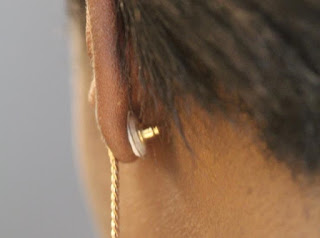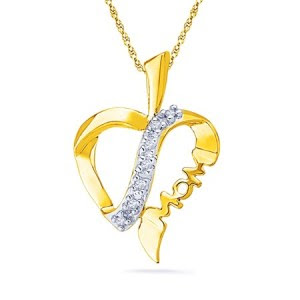Earrings to Prevent Pregnancy? Scientists Are Developing Contraceptive Jewelry
It uses transdermal patch technology.
Researchers say family planning for women could one day be as simple as putting on an earring.
A report published recently in the Journal of Controlled Release describes a technique for administering contraceptive hormones through special backings on jewelry such as earrings, wristwatches, rings or necklaces. The contraceptive hormones are contained in patches applied to portions of the jewelry in contact with the skin, allowing the drugs to be absorbed into the body, according to a press release from the Georgia Institute of Technology.
Initial testing suggests the contraceptive jewelry may deliver sufficient amounts of hormone to provide contraception, though no human testing has been done yet. A goal for the new technique is to improve user compliance with drug regimens that require regular dosages. Beyond contraceptives, the jewelry-based technique might also be used for delivering other drugs through the skin, according to the release.
“The more contraceptive options that are available, the more likely it is that the needs of individual women can be met,” said Mark Prausnitz, a Regents Professor and the J. Erskine Love Jr. chair in the School of Chemical and Biomolecular Engineering at the Georgia Institute of Technology. “Because putting on jewelry may already be part of a woman’s daily routine, this technique may facilitate compliance with the drug regimen. This technique could more effectively empower some women to prevent unintended pregnancies.”
Contraceptive jewelry adapts transdermal patch technology that is already used to administer drugs that prevent motion sickness, support smoking cessation, and control the symptoms of menopause, but have never been incorporated into jewelry before. Contraceptive patches are also already available, but Prausnitz believes pairing them with jewelry may prove attractive to some women – and allow more discreet use of the drug delivery technology.
“There is a lot of experience with making and using conventional transdermal patches,” he said. “We are taking this established technology, making the patch smaller and using jewelry to help apply it. We think that earring patches can expand the scope of transdermal patches to provide additional impact.”
Postdoctoral Fellow Mohammad Mofidfar, Senior Research Scientist Laura O’Farrell and Prausnitz tested the concept on animal models, first on ears from pigs. Test patches mounted on earring backs and containing the hormone levonorgestrel were also applied to the skin of hairless rats. To simulate removal of the earrings during sleep, the researchers applied the patches for 16 hours, then removed them for eight hours. Testing suggested that even though levels dropped while the earrings were removed, the patch could produce necessary amounts of the hormone in the bloodstream.
If the technique ultimately is used for contraception in humans, the earring back would need to be changed periodically, likely on a weekly basis.
The contraceptive jewelry was originally designed for use in developing countries where access to health care services may limit access to long-acting contraceptives such as injectables, implants and IUDs. However, Prausnitz says the technology may be attractive beyond that initial audience.
“We think contraceptive jewelry could be appealing and helpful to women all around the world,” said Prausnitz.
This proof-of-concept research was supported by the U.S. Agency for International Development.
If you are in search of large diamond hoops earrings and want to know more about it then please contact us in the comment section.
Researchers say family planning for women could one day be as simple as putting on an earring.
A report published recently in the Journal of Controlled Release describes a technique for administering contraceptive hormones through special backings on jewelry such as earrings, wristwatches, rings or necklaces. The contraceptive hormones are contained in patches applied to portions of the jewelry in contact with the skin, allowing the drugs to be absorbed into the body, according to a press release from the Georgia Institute of Technology.
Initial testing suggests the contraceptive jewelry may deliver sufficient amounts of hormone to provide contraception, though no human testing has been done yet. A goal for the new technique is to improve user compliance with drug regimens that require regular dosages. Beyond contraceptives, the jewelry-based technique might also be used for delivering other drugs through the skin, according to the release.
“The more contraceptive options that are available, the more likely it is that the needs of individual women can be met,” said Mark Prausnitz, a Regents Professor and the J. Erskine Love Jr. chair in the School of Chemical and Biomolecular Engineering at the Georgia Institute of Technology. “Because putting on jewelry may already be part of a woman’s daily routine, this technique may facilitate compliance with the drug regimen. This technique could more effectively empower some women to prevent unintended pregnancies.”
Contraceptive jewelry adapts transdermal patch technology that is already used to administer drugs that prevent motion sickness, support smoking cessation, and control the symptoms of menopause, but have never been incorporated into jewelry before. Contraceptive patches are also already available, but Prausnitz believes pairing them with jewelry may prove attractive to some women – and allow more discreet use of the drug delivery technology.
“There is a lot of experience with making and using conventional transdermal patches,” he said. “We are taking this established technology, making the patch smaller and using jewelry to help apply it. We think that earring patches can expand the scope of transdermal patches to provide additional impact.”
Postdoctoral Fellow Mohammad Mofidfar, Senior Research Scientist Laura O’Farrell and Prausnitz tested the concept on animal models, first on ears from pigs. Test patches mounted on earring backs and containing the hormone levonorgestrel were also applied to the skin of hairless rats. To simulate removal of the earrings during sleep, the researchers applied the patches for 16 hours, then removed them for eight hours. Testing suggested that even though levels dropped while the earrings were removed, the patch could produce necessary amounts of the hormone in the bloodstream.
If the technique ultimately is used for contraception in humans, the earring back would need to be changed periodically, likely on a weekly basis.
The contraceptive jewelry was originally designed for use in developing countries where access to health care services may limit access to long-acting contraceptives such as injectables, implants and IUDs. However, Prausnitz says the technology may be attractive beyond that initial audience.
“We think contraceptive jewelry could be appealing and helpful to women all around the world,” said Prausnitz.
This proof-of-concept research was supported by the U.S. Agency for International Development.
If you are in search of large diamond hoops earrings and want to know more about it then please contact us in the comment section.




Comments